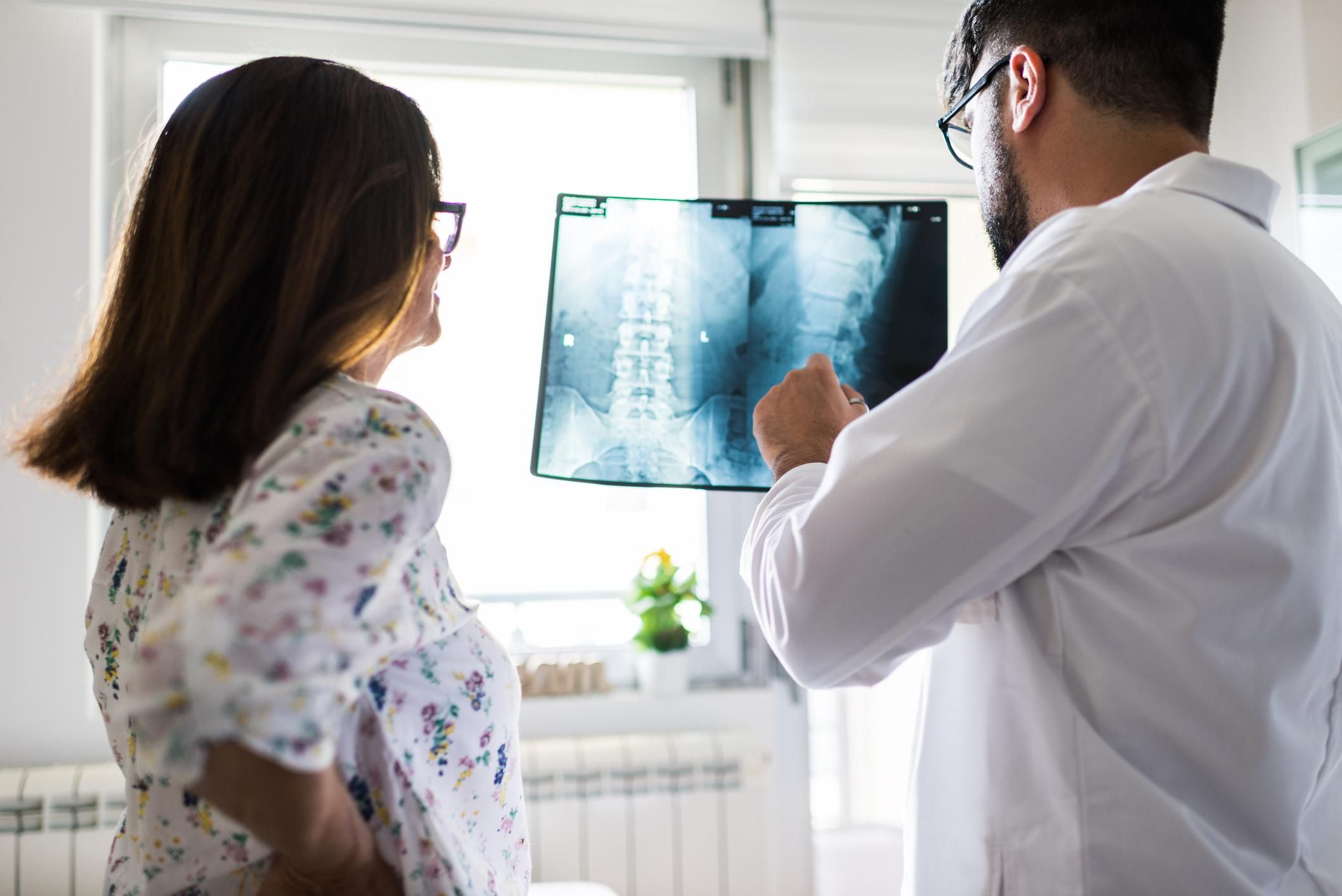This article has been archived. We will no longer be updating it. For our most up-to-date information, please visit our bone health information here.
Q:
What medications may be used to treat osteoporosis and what are the risks and benefits of each?
A:
Your bone is constantly undergoing change, with small areas of bone being removed and new bone being made. Most of the calcium in your body is stored in bone; bone is removed primarily to release calcium into your bloodstream to assist in crucial body functions, as such muscle activity. Osteoporosis occurs when more bone is lost than made. Most medications used to treat osteoporosis are intended to slow the loss of bone. The U.S. Food and Drug Administration (FDA) has approved several medications for postmenopausal women to help slow or stop bone loss, build bone and reduce the risk of fractures. These medications work well, but only when they are taken regularly. You need to have adequate calcium and vitamin D intake while taking these medications to prevent low blood calcium levels and to maximize your ability to build bone. As with any medication therapy, there are certain risks and side effects.
- Menopausal estrogen therapy and combination estrogen-progestin therapy. Although not approved by the FDA for the treatment of osteoporosis, oral and transdermal forms of estrogen, called estrogen therapy (ET), and combined estrogen-progestin, called hormone therapy (HT), are approved for preventing bone loss in recently menopausal women. Studies find that ET increases bone mass and reduces the incidence of vertebral (spine), wrist and hip fractures. However, because of the long-term risks associated with hormone replacement therapy, the FDA recommends that women first consider other osteoporosis medications and warns that hormone therapies should be used for the treatment of substantial menopausal symptoms, rather than to slow bone loss. When used, they should be at the lowest possible dose for the shortest possible time.
- Raloxifene (Evista). Available in pill form, this medication is approved for the prevention and treatment of osteoporosis in postmenopausal women. Raloxifene has positive estrogen-like effects on bone but not on the breast or lining of the uterus and may reduce the risk of estrogen-dependent breast cancer by 65 percent over four years. It is part of a class of drugs called selective estrogen receptor modulators (SERMs) that appear to prevent bone loss at the spine, hip and other points in the body. Studies find that raloxifene reduces the risk of spinal fracture in women with osteoporosis, but there are no data confirming that it reduces the risk of any other fractures. Possible side effects include hot flashes, blood clots in the veins (similar to estrogen) and leg cramps. The pill is taken once a day, with or without meals.
- Bisphosphonates. There are several medications within the bisphosphonate class of drugs. These medications work by slowing the cells that remove bone, allowing restoration of the balance between bone loss and formation. These drugs have been found to decrease your risk of fractures, although some are better at preventing fractures in the spine than other fractures. Since these medications slow bone loss, your body is not as able to release needed calcium from your bones. While taking these medications, you need to make sure your diet includes adequate amounts of calcium and vitamin D, which is needed to absorb calcium; if not, take calcium and vitamin D supplements. In addition to low blood calcium, another significant side effect of bisphosphonates is the development of fractures of the upper part of the thigh bone (femur) in people who take these medications for a long time. Here are some types of bisphosphonates:
- Alendronate (Fosamax and other brands, including generics). This is a bone-specific oral medication approved by the FDA to treat and prevent osteoporosis. Studies find alendronate increases bone mass and reduces the risk of spine, hip, wrist and other fractures by up to 50 percent in women with osteoporosis. Alendronate has also been approved for the treatment of glucocorticoid-induced osteoporosis and the treatment of osteoporosis in men. Alendronate tablets should be taken on an empty stomach in the morning and with eight ounces of water at least 30 minutes before the first food, beverage or medication of the day. To minimize side effects—which can include heartburn or irritation of the esophagus—remain upright for at least 30 minutes after taking this medication. Alendronate can be taken daily or as a weekly medicine regimen. An additional reported side effect of alendronate is the development of osteonecrosis (dead bone) of the jaw.
- Risedronate (Actonel). This oral medication is approved to treat and prevent osteoporosis in postmenopausal women and to prevent and treat glucocorticoid-induced osteoporosis in women and men. It can be taken once per day, once per week or once per month. Studies find it increases bone mass and reduce the risk of spinal, wrist, hip and other non-spinal fractures in women with osteoporosis. Take on an empty stomach in the morning with eight ounces of water, 30 minutes before eating or drinking. To minimize side effects—which can include heartburn or irritation of the esophagus—remain upright for at least 30 minutes after taking. Take any vitamins, calcium and antacids at least 30 minutes after you take risedronate.
- Ibandronate (Boniva). This oral medication has been approved by the FDA for prevention and treatment of osteoporosis in postmenopausal women. It reduces the incidence of vertebral fractures by about 50 percent and increases bone mineral density throughout the skeleton. Ibandronate also prevents bone loss in recent menopausal women but who do not yet have osteoporosis. Ibandronate must be taken once a month on an empty stomach, first thing in the morning, with eight ounces of water (no other liquid) at least 60 minutes before eating or drinking. Patients must remain upright for at least one hour after taking this medication. Ibandronate also may be given intravenously once every three months.
- Zoledronic acid (Reclast). Reclast is an intravenous medication (injected into a vein) and has been approved by the FDA to prevent postmenopausal osteoporosis for two years with a single dose or to treat postmenopausal osteoporosis with a once-yearly infusion. Zoledronic acid decreases the risk of fractures, including those of the spine and hip. It is given only once a year or once every two years (depending on the diagnosis) as a 15-minute intravenous infusion. Side effects include transient fever, muscle pain, pain in the bones or joints, flu-like symptoms and headache. These symptoms usually set in within the first three days of receiving zoledronic acid and generally go away within three to four days.
- Calcitonin (Miacalcin). This is approved for the treatment of osteoporosis in women who are five years postmenopausal and cannot tolerate estrogen therapy. Studies find that this medication helps slow bone loss, increases spinal bone density and may relieve fracture pain. Because calcitonin is a protein, it cannot be taken orally, so it is taken as a nasal spray or, in some instances, an injection. Possible side effects include nasal irritation and inflammation, bloody nose, headache and backache. Injectable calcitonin may cause an allergic reaction and flushing of the face and hands, frequent urination, nausea and skin rash. Calcitonin isn't as potent at treating osteoporosis as other medications, so it is usually reserved for people who can't take other drugs or for control of the pain associated with fractures.
- Teriparatide (Forteo). A form of parathyroid hormone, this is the first medication that stimulates bone formation instead of slowing the breakdown of bone. It is approved for postmenopausal women and for men at high risk for fractures. It increases bone mineral density and reduces fractures in postmenopausal women. The drug is administered by injection once a day (for up to 24 months). Side effects may include nausea, dizziness and leg cramps.
- Denosumab (Prolia). This injectable treatment, approved by the FDA in 2010, is a fully human monoclonal antibody. It offers another option for postmenopausal women with osteoporosis who are at high risk for fracture. It works to decrease the loss of bone and increase bone mass and strength. An injection is recommended every six months. Side effects may include back pain, pain in the extremities, musculoskeletal pain, high cholesterol levels and urinary bladder infections. Serious adverse reactions include low calcium levels in the blood, serious infections, and skin reactions such as dermatitis, rashes and eczema. Similar to bisphosphonates, Denosumab causes significant suppression of bone turnover (bone loss and formation), which may contribute to the occurrence of atypical fractures, especially of the upper thigh bone (femur); slower fracture healing; and osteonecrosis of the jaw, a severe bone disease affecting the jaw.
Talk to your health care provider about the benefits and risks of taking osteoporosis medication and discuss what treatment and prevention options are best for you, with your health history in mind.
Keep in mind that osteoporosis medication is one of several strategies for prevention or treatment of this common condition. Weight-bearing exercise and a diet containing adequate calcium and vitamin D, with supplements as needed, also are important to help keep your bones strong.
To learn more about osteoporosis and preventing broken bones, visit these sites:
https://healthywomen.org/condition/osteoporosis
https://www.usbji.org
https://www.fit2t.org


